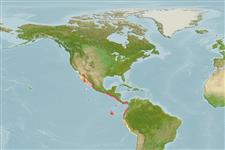Common names from other countries
Environment: milieu / climate zone / depth range / distribution range
Ecología
marino demersal; rango de profundidad 23 - 306 m (Ref. 9342). Subtropical; 34°N - 19°S, 120°W - 70°W
Eastern Pacific: Playa del Rey in southern California, USA to Peru.
Tamaño / Peso / Age
Maturity: Lm ? range ? - ? cm
Max length : 42.0 cm TL macho / no sexado; (Ref. 9342); peso máximo publicado: 680.00 g (Ref. 40637)
A sharp spine projecting anteriorly from ventral border of urohyal (Ref. 40817).
Probably forms schools and lives near the bottom in deep waters (Ref. 9342). Of some commercial importance in zones where it is abundant (Ref. 9342).
Life cycle and mating behavior
Maturities | Reproducción | Spawnings | Egg(s) | Fecundities | Larva
Eschmeyer, W.N., E.S. Herald and H. Hammann, 1983. A field guide to Pacific coast fishes of North America. Boston (MA, USA): Houghton Mifflin Company. xii+336 p. (Ref. 2850)
IUCN Red List Status (Ref. 130435)
CITES (Ref. 128078)
Not Evaluated
Threat to humans
Harmless
Human uses
Pesquerías: escaso valor comercial
Herramientas
Special reports
Download XML
Fuentes de Internet
Estimates based on models
Preferred temperature (Ref.
115969): 13 - 21.4, mean 15.2 (based on 78 cells).
Phylogenetic diversity index (Ref.
82804): PD
50 = 0.6250 [Uniqueness, from 0.5 = low to 2.0 = high].
Nivel trófico (Ref.
69278): 3.7 ±0.5 se; based on size and trophs of closest relatives
Resiliencia (Ref.
120179): Medio, población duplicada en un tiempo mínimo de 1.4-4.4 años (Preliminary K or Fecundity.).
Fishing Vulnerability (Ref.
59153): Low to moderate vulnerability (32 of 100).
